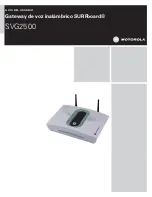
6.1.2. IP Spoofing
Traffic that pretends it comes from a trusted host can be sent by an attacker to try and get past a
firewall's security mechanisms. Such an attack is commonly known as Spoofing.
IP spoofing is one of the most common spoofing attacks. Trusted IP addresses are used to bypass
filtering. The header of an IP packet indicating the source address of the packet is modified by the
attacker to be a local host address. The firewall will believe the packet came from a trusted source.
Although the packet source cannot be responded to correctly, there is the potential for unnecessary
network congestion to be created and potentially a Denial of Service (DoS) condition could occur.
Even if the firewall is able to detect a DoS condition, it is hard to trace or stop because of its nature.
VPNs provide one means of avoiding spoofing but where a VPN is not an appropriate solution then
Access Rules can provide an anti-spoofing capability by providing an extra filter for source address
verification. An Access Rule can verify that packets arriving at a given interface do not have a
source address which is associated with a network of another interface. In other words:
•
Any incoming traffic with a source IP address belonging to a local trusted host is NOT allowed.
•
Any outgoing traffic with a source IP address belonging to an outside untrusted network is NOT
allowed.
The first point prevents an outsider from using a local host's address as its source address. The
second point prevents any local host from launching the spoof.
6.1.3. Access Rule Settings
The configuration of an access rule is similar to other types of rules. It contains Filtering Fields as
well as the Action to take. If there is a match, the rule is triggered, and NetDefendOS will carry out
the specified Action.
Access Rule Filtering Fields
The Access Rule filtering fields used to trigger a rule are:
•
Interface: The interface that the packet arrives on.
•
Network: The IP span that the sender address should belong to.
Access Rule Actions
The Access Rule actions that can be specified are:
•
Drop: Discard the packets that match the defined fields.
•
Accept: Accept the packets that match the defined fields for further inspection in the rule set.
•
Expect: If the sender address of the packet matches the Network specified by this rule, the
receiving interface is compared to the specified interface. If the interface matches, the packet is
accepted in the same way as an Accept action. If the interfaces do not match, the packet is
dropped in the same way as a Drop action.
Note: Enabling logging
Logging can be enabled as required for these actions.
Turning Off Default Access Rule Messages
6.1.3. Access Rule Settings
Chapter 6. Security Mechanisms
243
Summary of Contents for DFL-1600 - Security Appliance
Page 27: ...1 3 NetDefendOS State Engine Packet Flow Chapter 1 NetDefendOS Overview 27 ...
Page 79: ...2 7 3 Restore to Factory Defaults Chapter 2 Management and Maintenance 79 ...
Page 146: ...3 9 DNS Chapter 3 Fundamentals 146 ...
Page 227: ...4 7 5 Advanced Settings for Transparent Mode Chapter 4 Routing 227 ...
Page 241: ...5 4 IP Pools Chapter 5 DHCP Services 241 ...
Page 339: ...6 7 Blacklisting Hosts and Networks Chapter 6 Security Mechanisms 339 ...
Page 360: ...7 4 7 SAT and FwdFast Rules Chapter 7 Address Translation 360 ...
Page 382: ...8 3 Customizing HTML Pages Chapter 8 User Authentication 382 ...
Page 386: ... The TLS ALG 9 1 5 The TLS Alternative for VPN Chapter 9 VPN 386 ...
Page 439: ...Figure 9 3 PPTP Client Usage 9 5 4 PPTP L2TP Clients Chapter 9 VPN 439 ...
Page 450: ...9 7 6 Specific Symptoms Chapter 9 VPN 450 ...
Page 488: ...10 4 6 Setting Up SLB_SAT Rules Chapter 10 Traffic Management 488 ...
Page 503: ...11 6 HA Advanced Settings Chapter 11 High Availability 503 ...
Page 510: ...12 3 5 Limitations Chapter 12 ZoneDefense 510 ...
Page 533: ...13 9 Miscellaneous Settings Chapter 13 Advanced Settings 533 ...












































